
by Lidia Paulinska | Dec 1, 2015
The latest version of the MobileLite Wireless product is much more mobile phone centered than past versions. The G2 version starts by adding a Li-ion battery that can provide 13 hours of continuous use for the device or be used to charge your mobile phone. While prior versions were targeted at the whole mobile market which includes laptops, tablets and phones, this new version is very size and feature targeted towards phones.
One of the main new features is the ability to support video streaming to multiple devices as well as camera roll support. The portable device still has a wireless 802.11g/n WiFi and a router capability along with USB and SD card support. The unit was updated to support the SD-XC extended capacity cards that now on the market. For security, the device allows for setting up your own SSID name for the network, and encryption on the WiFi.
The list of mobile device operating systems and platforms has expanded to include iPad2, iPad (3rd & 4th Gen), iPad Air, iPad mini, iPhone 4/4S/5, iPod Touch, Kindle Fire, Kindle Fire HD, and Android. As a wire connected product, it works with Windows 8.1, Windows 8, Windows 7, Windows Vista, Mac OS X, and Linux. The device is available for the holiday season.

by Lidia Paulinska | Nov 28, 2015
The two-day KTech – KGlobal@Silicon Valley 2015 symposium and expo organized by the Korean Ministry of Science, ICT & Future Planning along with KOTRA Silicon Valley; was dedicated to promote Korean technology and its ties with Silicon Valley. The event took place on November 12-13, 2015 at Marriott hotel in Santa Clara, CA. The opening remarks were delivered by Yong Soo Kim, Assistant Minister of Science, ICT and Future Planning, ChangYup Na, Managing Director of KOTRA in Sillicon Valley, Jong-Lok Yoon, President of National IT Industry Promotion Agency, Congressman Mike Honda from 17th District of California and Dongman Han and Consul General of Republic of Korea in San Francisco.
The main theme of this year event was “Automated Future: Human + Technology”.
The first keynote speaker Curtis Sasaki, Vice President of Ecosystems and IoT General Manager from Samsung Electronics stated that in 2020 many of our devices will be connected. Sasaki who worked in the past at Apple and Sun Microsystems, and today at Samsung, the most recognizable brand from Korea, described some effort and the products that company offers: Samsung Sleepsense, the sleep monitor, Samsung Gear S2, stylish and smart watch, and Samsung gear VR. According Sasaki, next area where we should expect a lot of traffic is VR (Virtual Reality). And VR is not just for a gaming but may also conquer other territories such as real estate, where surprisingly, people are willing to buy a house without visiting it or in education where the technology can offer the VR tour of the world in every school. Samsung applied the VR in their smartphones, like the Galaxy 5, and just headphones are needed to get a VR experience. In his summary, Sasaki pointed out the challenges that society faces nowadays and summarized the solutions: IoT can be a catalyst, partnerships are critical, technology and innovation are moving at an even faster pace than in the past.
A world experienced wide robotics revolution – stated second keynote speaker Rodney Brooks, Founder, Chairman and CTO of Rethink Robotics – sustaining growth in the face of demographic inversion. Brooks is convinced that time for the robots to interact with humans in the daily life is now. As he described it: It knows what you mean and it does what you want. Radical rethinking of manufacturing strategies is underway. The time is now because of convergence of Industrial Internet (Intelligent devices networked into intelligent systems), Additive manufacturing (Changing the economics of scale), Near-shoring (Benefit of low-cost outsourcing is eroding), Digital revolution (Cheap sensing, cheap computation, pervasive connectivity). As the population enjoys long life expectancy the robotics is going to get pulled into in home for elder care and find it use in the aging population. Brooks showed the statistics from Europe, 1950 when the population reaches 349.8 million and life longevity was 80, in Europe 2050 the population will be 401 million with life longevity to the late 90. The speaker reminded the audience that the first commercial robot was developed was in a GM factory in New Jersey in 1961. Today robotics represents baxter, research robot; the product of robust and growing developer community sharing code and applications, uses the Unified RobotDesriptor Format (URDF) for collaboration across groups, uses open source ROS framework, the standard in academia and corporate research, complete robotics platform with low-level control for custom application development, interface for custom end-effector development.
The keynote speakers set the mood for a vibrant Automated Future: Human + Technology panel discussions over the next two –days of KTech symposium. Meanwhile more than 35 Korean companies in security, wearables, big data, e-learning, hardware and software were presenting their solutions for the world at the expo area along with international job fair at the Marriott hotel in Santa Clara.
Photos of the event can be found at: https://brightblueii.com/photos/ktechsilicon-valley-2015/
More information at the website: http://www.ktechsv.org/
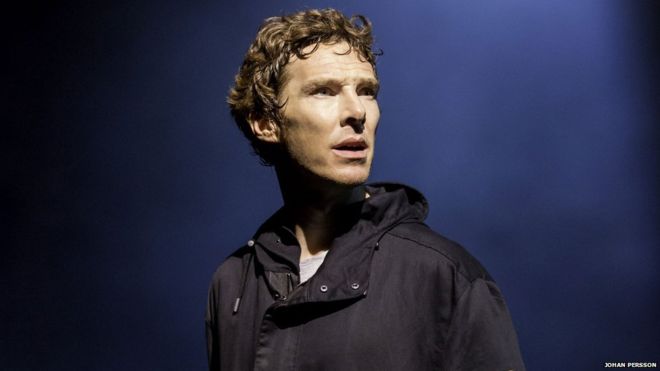
by Lidia Paulinska | Nov 28, 2015
On the evening of November 10, 2015, thousands of fortunate theatre-goers world-wide were treated to a rare theatrical experience. They were offered the opportunity, through the good graces of Fathom Events, to witness a filmed live presentation of William Shakespeare’s immortal tragedy, Hamlet staring Benedict Cumberbatch of “The Imitation Game” fame in the title role. And a rare treat it was.
At the ripe old age of 400, Shakespeare’s iconic work, bursting at the seams with 4,000 vibrant lines of verse and prose, is as vital and relevant today as it was to audiences in the 17th century. An un-cut version of the play can run up to a daunting four hours, yet in an age of instant global communication and fast food, it nonetheless remains for us one of the greatest works of dramatic literature ever penned. Shakespeare not only belongs to the ages…he belongs to the world. In fact, his 37 plays have been translated into more than 100 languages and in the past ten years alone there have been seven professional productions in Arabic and over the years countless amateur and professional performances have been done in Yiddish.
Shakespeare’s plays were performed at the fortuitously named Globe theatre in Elizabethan London, a large round “wooden O” which was open to sky and could accommodate 1,500 spectators, with the gentry seated above and commoners standing below in the yard and having put 1 penny in a box at the entrance (origin of term “box office”) for the privilege. The bare stage thrust out into the yard where those Groundlings (also called “Stinkards”) stood and was completely devoid of any scenery. Consequently, the actor relied almost exclusively on Shakespeare’s dialogue to fix the location of the action. Such lines as “Here we are in the Forest of Arden” fulfilled this demand admirably. Costumes and props were minimal, limited to perhaps an occasional crown or sword, with Claudius no doubt wearing an identifying crown and Hamlet with sword in hand, dispatching the hapless Polonius behind the areas in Gertrude’s bed chamber. “Thou wretched, rash, intruding fool, I took thee for thy better.”
But that was then, and even though the language of the plays has remained constant throughout the centuries, what has changed radically has been the style of acting and the entire miss en scene, i.e., the sets and scenic design elements, the sophisticated computerized lighting, the elaborate costumes, etc., all determined by the culture of the time and place where the plays were performed. A minority of productions have remained faithful to the bare stage tradition of the Elizabethan period such as Richard Burton’s dynamic, bare-bones1964 Broadway presentation, performed on a bare stage with actors performing in rehearsal clothes (Burton hated period costumes). In contrast to that production, we need look no further than the over-the-top, sumptuously extravagant 1996 Kenneth Branagh film version which he directed and played the title role. His is a Hamlet that pulled out all the stops and was roundly criticized for it, not being “faithful” to the original text it was claimed. In one scene for example, Ophelia is in a padded cell sporting a straight jacket with little evidence in Shakespeare’s text of such a fate.
The National Theatre’s offering at the Barbican clearly leaned more to the Branagh rather than the Burton tradition, but with infinitely greater moderation, being quite legitimately, a richly staged production which captured the dark essence of the play. Here we have an Elsinore that is dank, cold and cavernous, dwarfing its doomed inhabitants, and being at once both elegant and decadent, fostering a thematic tone of foreboding that took on the qualities of a forbidding damp tomb, perfectly complementing the emerging tragedy that is unfolding.
And Shakespeare’s language? Mr Cumberbatch, ably backed by a splendid supporting cast, delivered his lines with an honesty and clarity that immediately engaged his audience and allowed Hamlet to come alive for us through the immediacy of the emotion he so effectively conveying. His was not so much the traditional “melancholic Dane” as he was a man beset by overwhelming passions and unbridled fury, the inevitable escape from which could only be realized in death.
If, as Hamlet extols to the visiting players, “the play’s the thing…”, then this well balanced, forceful production of Hamlet, splendidly sculptured for a 21st century audience, fulfilled that admonishment.
Lidia Paulinska and Hugh McMahon
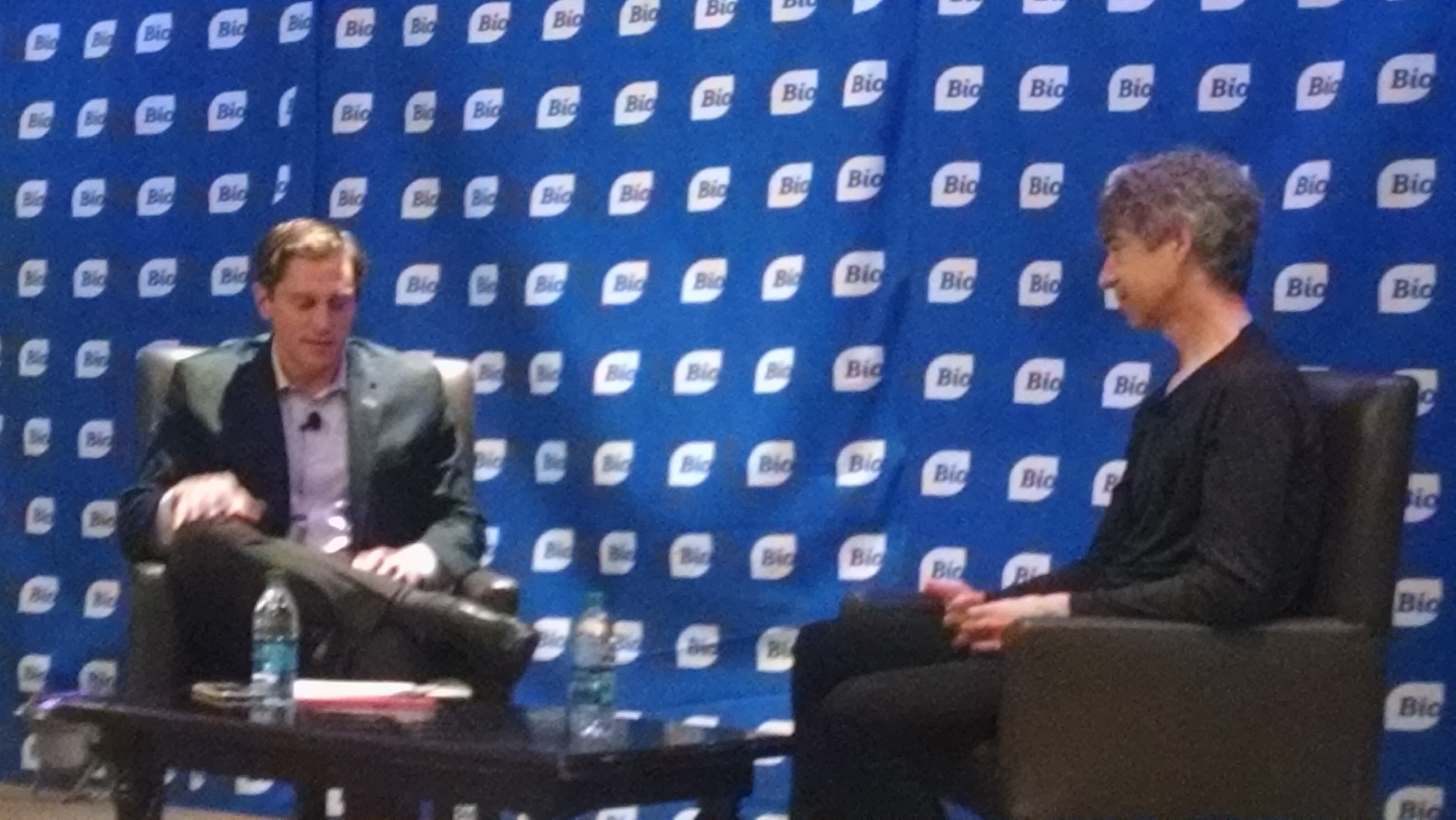
by Lidia Paulinska | Nov 25, 2015
The lunchtime plenary session at the Bio Investor Forum in San Francisco featured a fireside chat with BioTech investor Robert Nelsen. Nelsen described himself as a self-motivated investor who started his investment in projects at age 11. His key strategy today and main personal belief on investing is that science and technology matters, and that basic research is key. His premised was explained in his love the Scientific American which has a section showing the understanding and ideas in science 10, 20 and 50 years ago. The results shown in this section, are that what science understood at a given time was wrong based on the current understanding and science. This is an on-going challenge, as the improvements in science research and the interpretation of the results are constantly returning new explanations for basic science, and delivering new opportunities for business.
Using this information, Nelsen believes that companies should try new things and in new ways to learn the best ways to make something right, based on the latest information available. This mentality allows Robert to invest and focus big hard problems that multiple angles and aspects to address the problem. This gives multiple opportunities to find valid solutions over traditional methods. An area of the biggest interest is psychological drugs which address the varied space of Alzheimer’s disease and depression.
Right now, the cost of treatment and medication is 80% of the cost of a reactive care treatment plan. The cost increased as hospitalization and invasive methods are tried. He believes that many of these cases can be treated with drugs rather than invasive physical care. This would bring the treatment to an out-patient methodology, and dramatically impact the $3T in physical care billing annually.
From an investment and business strategy, the IP piece is secondary to getting the right scientists on the best practice for the program. The place for these pieces is cures require first line defensive IP, secondarily in the marketplace offensive position IP. This idea yields a belief that in the bay area, with the right strategy and the right team (good science and good people) can do anything and can beat big pharma to market and with innovative products.

by Lidia Paulinska | Nov 24, 2015
Holiday spectacular event hosted by Pepcom in San Francisco on October 28 was featuring some great gifts ideas for quickly approaching holiday’s season. This annual event provides a sneak peak into the offering at CES coming up after the holiday season in January. This year’s event had over 50 exhibitors presenting the new or improved version of their electronic consumer targeted products, most of which are available for the 2015 holiday season. A highlight list of some of the more interesting products at the show follow.
AeroGarde is the indoor gardening system that lets you grow fresh herbs and vegetables all year-round. This is a standalone “pod” with its own grow light source to be used indoors in any location is produced by the Miracle Gro company.
ArcSoft demos Perfect365, its celebrity favorite, 65 million user, digital makeover app and simplicam Wi-Fi home monitoring camera with both face detection and face recognition.
BACtrack showcased BACtrack Vio and BACtrack Mobile smartphone breathalyzers; featuring Bluetooth connectivity and iOS and Android compatibility. These powerful devices allow users to quickly and easily estimate their BAC (Blood Alcohol Content) and make smarter, more informed decisions.
Beddit Smart sleep tracker makes any bed a smart bed by combining an ultra-thin sensor placed under the bed sheet with an iOS device; there’s nothing to wear and nothing to do but go to sleep.
Belkin, WeMo and Linksys showed off their latest products for the holiday season including new smart home gadgets, smartphone and tablet accessories and wireless networking gear.
Bitdefender 2016 come with a new ransomware protection that prevents untrusted applications from tampering personal documents and “machine learning-based technologies” that enables it to detect even brand new threats faster than ever.
Canary is a complete security system packed into a single device that you control from your smartphone.
Cobra Electronics and sister companies Escort, Inc. and Beltronics showcased their newest models of radar detection systems, featuring digital signal processing (DSP) technology for award-winning range and added rejection of false or unwanted alerts. Also on display will be Cobra’s recently released Cobra JumPack™ CPP 8000 portable power/jump starter system and Drive HD™ Dash Cams.
ecobee3 now includes geo-fencing in addition to Siri and room sensors, for more intuitive control of your home comfort, particularly in the rooms that matter most.
ESET showed its latest cybersecurity solutions that protect people from cyber threats while shopping, banking, doing email and more.
Exeo Entertainment, Inc. is an interactive entertainment company that manufactures patented Psyko® 5.1 surround sound gaming headphones and Krankz™ lifestyle branded music headphones.
Fizzics showed the world’s first personal beer dispenser that delivers a fresh from the tap experience from any bottle, can or growler.
FLIR Systems showed its latest consumer devices designed to enhance visual perception and awareness for home, work and play.
Gazelle showed Gazelle Certified™ pre-owned iPads.
Hasbro showed Playmation table that allow experienced this groundbreaking system of toys and wearables. The next step in the evolution of play, where digital gets physical and imagination becomes real.
HTC showed the newest addition to the HTC One family, unveiled last week, the HTC One A9.
Huawei presented the latest Smartphones, wearables and tablets.
iBaby Labs Not only revealed Helmet, a family monitor under the new iFamCare brand, iBaby Labs will showcase its award-winning baby monitors.
Immersion demonstrated the latest consumer electronic device and video game to launch with its TouchSense haptic technology – for more dynamic, versatile, touch effect experience – expected to be on the market this fall.
IMVU is the #1 avatar-based social network, introduced 3D stickers to bring your online conversations to life.
JLab Audio showed the Epic Bluetooth Earbuds, a lightweight, sweatproof fitness headphone that provides a customized fit and 10-hour battery life.
Kingston Technology showcased its latest selection of gaming, mobile, and memory products that get you into the action and keep going wherever you are.
Loot Crate, best known for shipping themed mystery boxes of the best geek, gaming, and pop culture gear, showcased the company’s holiday 2015 line-up.
Martian Watches debuted its recently launched Active Collection of award-winning Voice Command Smartwatches; water resistant smartwatches that honor classic analog designs with advanced features like voice commands, Smart Notifications and access to thousands of apps.
Master Lock showed its new line of Bluetooth Smart Padlocks, a new level of convenience and security that turns your smart device into a key.
MoCA® –Multimedia over Coax Alliance, demonstrated how networking products with MoCA from members Actiontec and TiVo turn existing coax TV cable into a powerful, easy to use wired backbone that supports and extends Wi-Fi®.
Moshi presented new bags, cases and speakers designed for the stylish tech connoisseur.
Muse is the brain sensing headband, helps you to take the guesswork out of meditation by giving real-time audio feedback that motivates and guides you through a more fulfilling and ongoing meditation practice.
NETGEAR showed its latest solutions for supporting the increasing number of Internet devices that enable your networked life: routers, extenders, adapters, security cameras, cable modems, and mobile WiFi hotspots.
Parallels presented Parallels Desktop 11 for Mac and the Parallels Access mobile app (for iOS and Android devices plus PCs and Macs).
Performance Designed Products demonstrated the latest gaming accessories from the Afterglow and Rock Candy brands, along with premium licensed products like the Official PS4 Universal Media Remote.
PERI, Wi-Fi audio technology company showcased its Duo product, a first-of-its-kind iPhone case featuring high-definition Wi-Fi and Bluetooth enabled speakers and a 3000mAh battery.
Petzila showed off the Petzi Treat Cam that lets people (‘see’) video, (‘speak’) audio, (‘snap’) take pictures and (‘treat’) dispense treats to their pets at anytime from anywhere.
Piper Icontrol Networks is showing Piper nv, its all-in-one home security system with no monthly fees required; ideal for families, pet owners, aging parents and apartment dwellers.
Plantronics is a global leader in audio communications for businesses and consumers and has pioneered new trends in audio technology.
PlayOn demonstrated technology for the new way we watch TV. Stream, record, cast, discover.
Ring presented its Ring Video Doorbell, the world’s first Wi-Fi-enabled HD video doorbell that streams live audio and video directly to your iOS, Android or Windows device.
Roominate showed rPower, the first device that lets girls program and control their builds from a phone or tablet through the new Roominate app.
Rover.com showcased the latest services and technologies of its peer-to-peer marketplace that connects dog owners with a nationwide network of dog lovers.
SanDisk showcased its latest mobile memory solutions.
Skyrocket Toys presented the third generation of Sky Viper Drones which continue to deliver hobby-level performance at unprecedented mass market pricing and availability, and includes a Streaming Video Drone, an HD Video Drone, a Stunt Drone and an lightweight and nimble, Nano Drone.
Sling Media showed the Slingbox M2, its newest product which allows to watch 100 percent of your live and recorded content on unlimited mobile devices, with no monthly fees.
SpeedX just launched SpeedX, a fully integrated smart cycling computer, on Indiegogo on October 27.
Tech21 is the leader in impact protection for mobile devices and fastest growing major case brand in the U.S., now offers its Evo line of cases, presenting the best in style, protection and performance with a broad array of designs and colors.
The ONE Smart Piano is a connected device that teaches you to play with light-up keys, video lessons, and piano games.
TiVo showcasted the new TiVo BOLT, a 4K unified entertainment system & mobile experience that bridges cable & Web content into a universally searchable experience, allowing users to skip full commercial breaks and watch shows 30% faster for unprecedented speed to and through content.
TP-LINK, the world’s leading provider of Wi-Fi networking products, showcased next-generation wireless technology, including its first Tri-Band and MU-MIMO routers.
TripIt from Concur, the world’s highest-rated travel-organizing app, automagically creates a master itinerary for every trip, so you can instantly access all your travel plans in one place—any time, on any device.
VidMob demonstrated the first app marketplace, coming soon for iOS, which connect people with affordable, professional video editors so that life’s moments can be more easily shared.
ZAGG showcased its brand new Slim Book for the iPad Mini 4, in addition to other key products like the Pocket Keyboard and Speaker Case.
Zolt showed the Laptop Charger Plus, the world’s smallest, lightest, smartest laptop charger that can power a laptop, phone and tablet at the same time.
ZTE presented devices that make the perfect gift for every budget.

by Lidia Paulinska | Nov 23, 2015
At the ARM TechCon in Santa Clara, Texas based Ambiq Micro announced the capabilities of their latest MCU for the IoT market. In an overview dinner with CEO Mike Noonen, VP of Marketing and Strategy Mike Salas, CTO Scott Hanson and VP Sales Vince Murdica they discussed the release of their new 32 bit MCU for the wearables and IoT market that is based on the ARM Cortex Core. The design uses the Ambiq Micro Sub-threshold technology to produce a processor that can be benchmarked at the lowest power in its class.
The product has recently moved to volume production, and is being used in a currently available sleep monitor and fitness monitor. To support the design, which is an ARM M4 core with FLASH memory and FPU, is a software development kit, a Free RTOS and a full development board. Wireless development products, supporting a Bluetooth Low Energy connection, from their partner Dialog Semiconductor, were on display at the show. All of these development products are currently available.
The system can be operated at voltages down to 2 volts which allows the system to have extended operation between charges, bringing new lifestyle applications to the IoT and wearables marketplace.

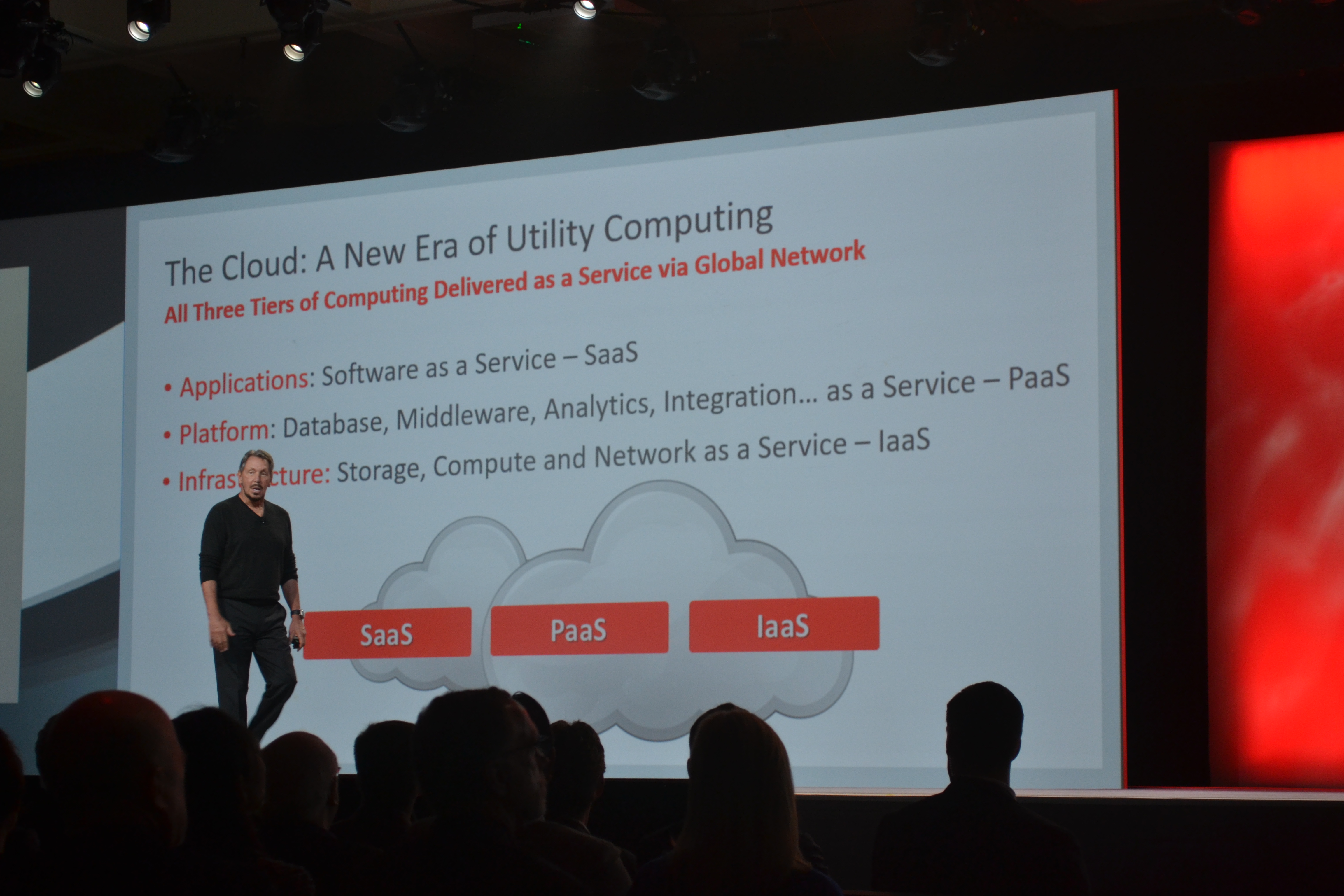
by Lidia Paulinska | Nov 20, 2015
A proclamation at the event is that “the era of utility computing is here”. This new shift in computing is no less important than the introduction of personal computers to the general public in the 1970’s. At that time, nobody believed that computers could be a personal device, explained Executive Chairman and CTO Larry Ellison at Oracle OpenWorld 2015.
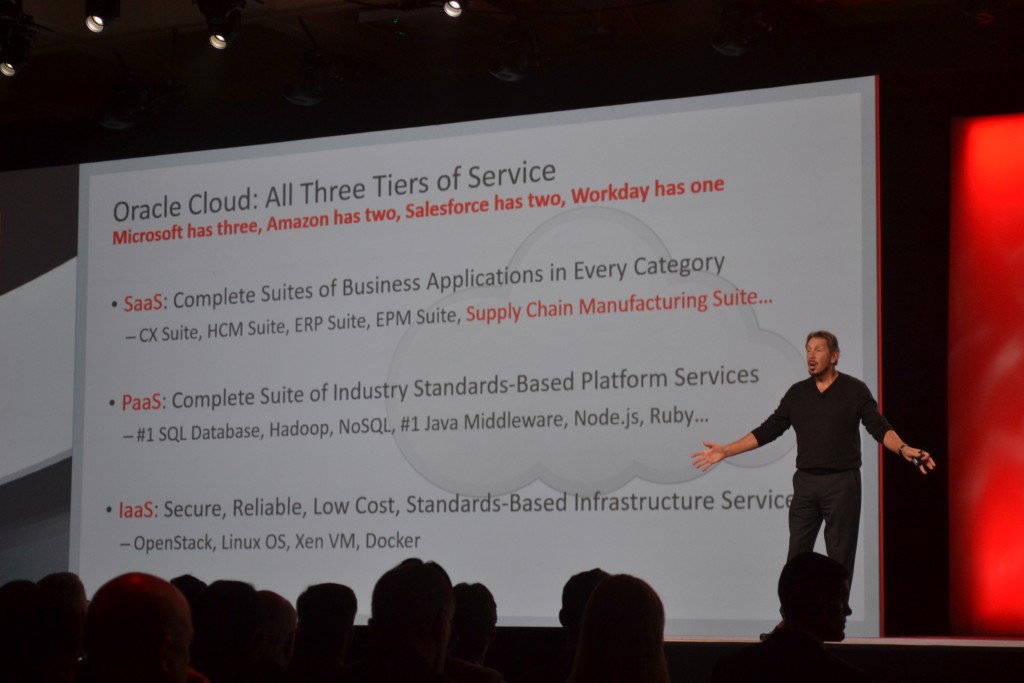
In his opening keynote Ellison unveiled the new Oracle SaaS applications and other advances in the Oracle Cloud. The biggest cloud companies are now worth 6 billion dollars and will be soon more. Oracle realized that the importance of the cloud a decade ago, and re-wrote all its applications to run in the cloud also. In 2015, Oracle is focused on engineering, cost, performance, reliability, compatibility, security and standards in the three layers of the cloud: SaaS, PaaS and IaaS.
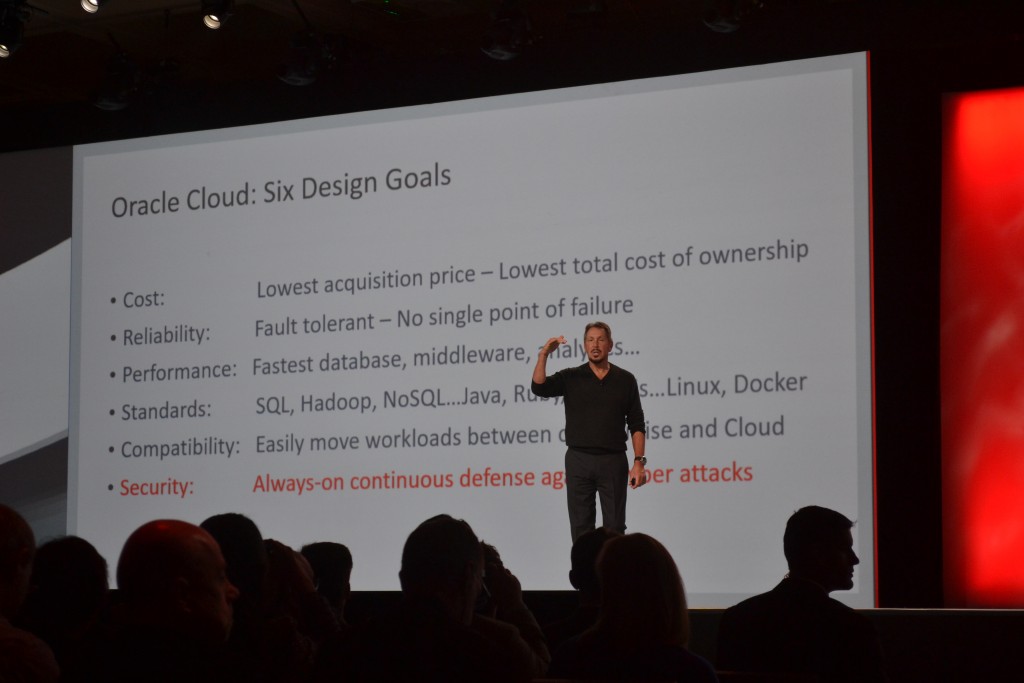
Oracle Cloud: Six Design Goals:
Lower Cost: 1. Lower Price: Match or beat Amazon Web Services Prices 2. Automation: Eliminate labor and human error 3. Productivity: Reduce labor by making it easier to build and use applications
Highest Reliability: 1. Fault Tolerant: Redundant deployment, hot patching & backup, instant recovery 2. Automation: Eliminate human error during deployment, patching, backup, recovery
Highest Performance: 1. Database: In-memory In-flash columnar database, Exadata in the Cloud 2. Middleware: In-memory speed-of-through Analytics 3. Scale-out Architecture: Elastic capacity and performance on-demand
Open Standards: 1. SQL, Hadoop, NoSQL…Java, Ruby, Node.js…Linux, Docker. No Lock-in: Move Workloads and data to the other Public Clouds: Amazon, Microsoft…
Compatibility: 1. Manage: Public Cloud and Private Cloud assets with a single pane of glass 2. Coexistence: Push-button live data migration between Oracle Public & Private Cloud
Always-On Security: 1. Security in Silicon: Always-on-real-time intrusion detection stops data theft 2. Data Encryption: Always-on in the Cloud – Key management on-Premise
The opening of the event had details of the major announcements presented by Mr Ellison, the first of these was about the Oracle SCM Cloud.
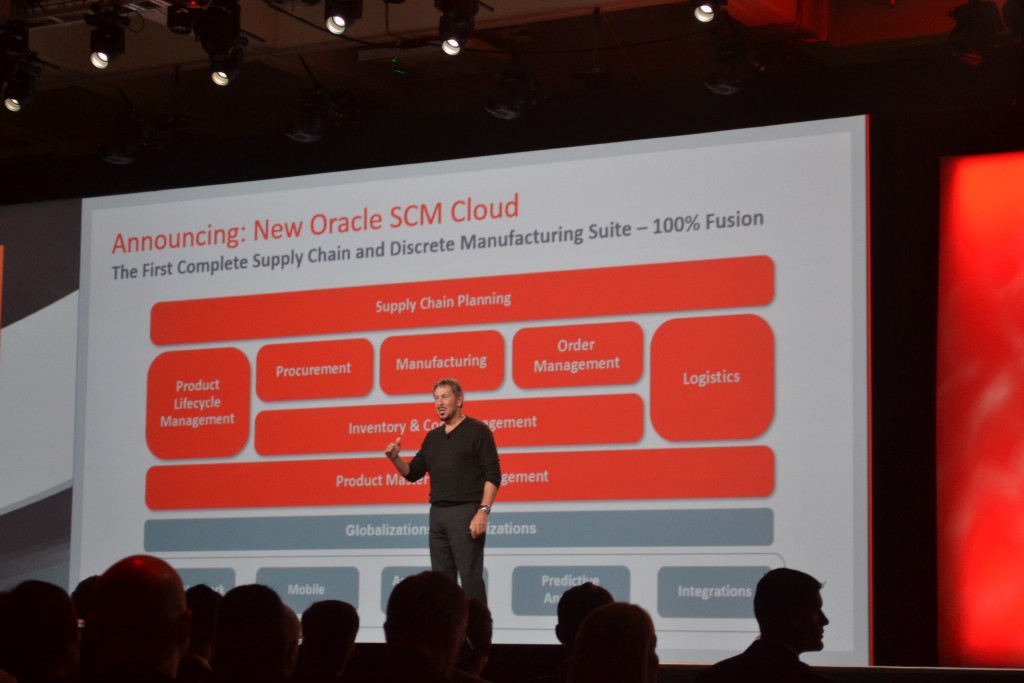
The second was about E-Commerce in the CX cloud.
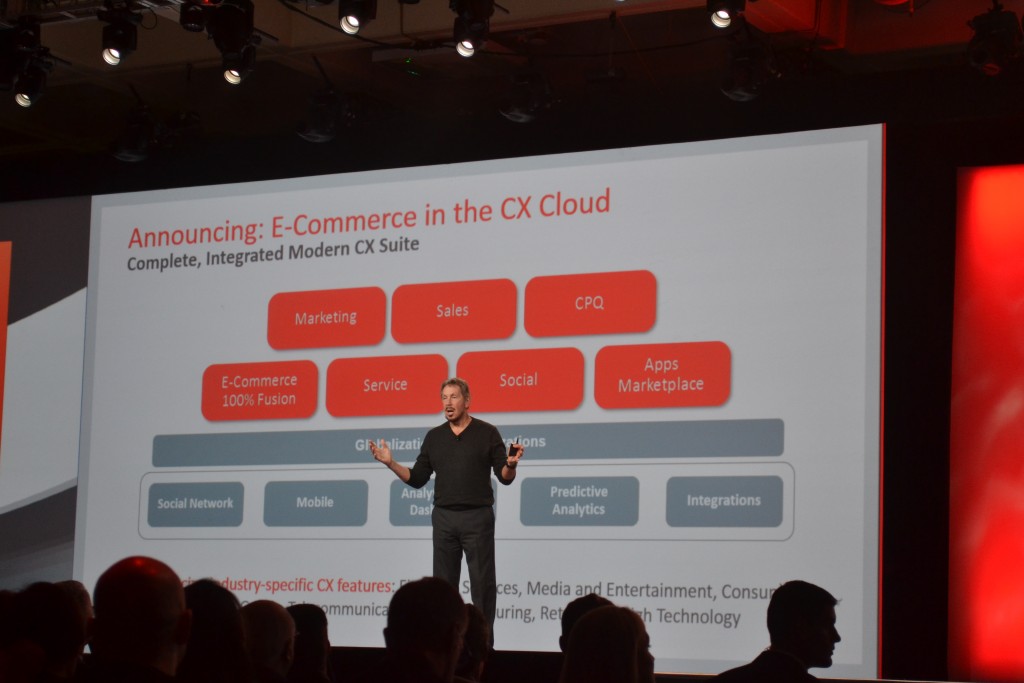
The third announcement was about the new mobile UI.
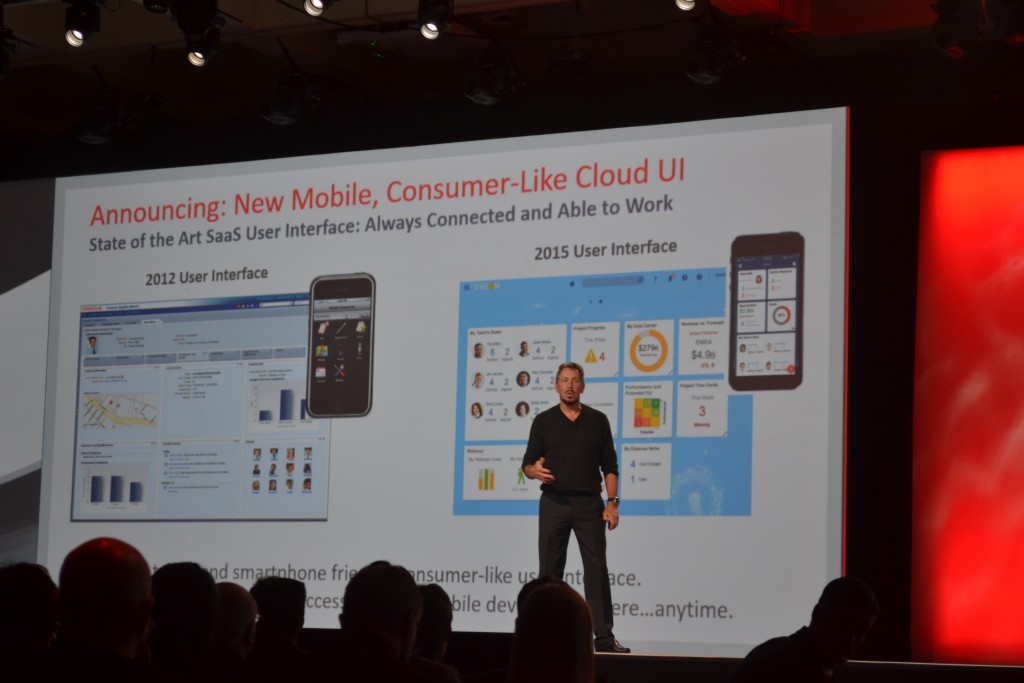
The last announcement was about Integrated Learning System.
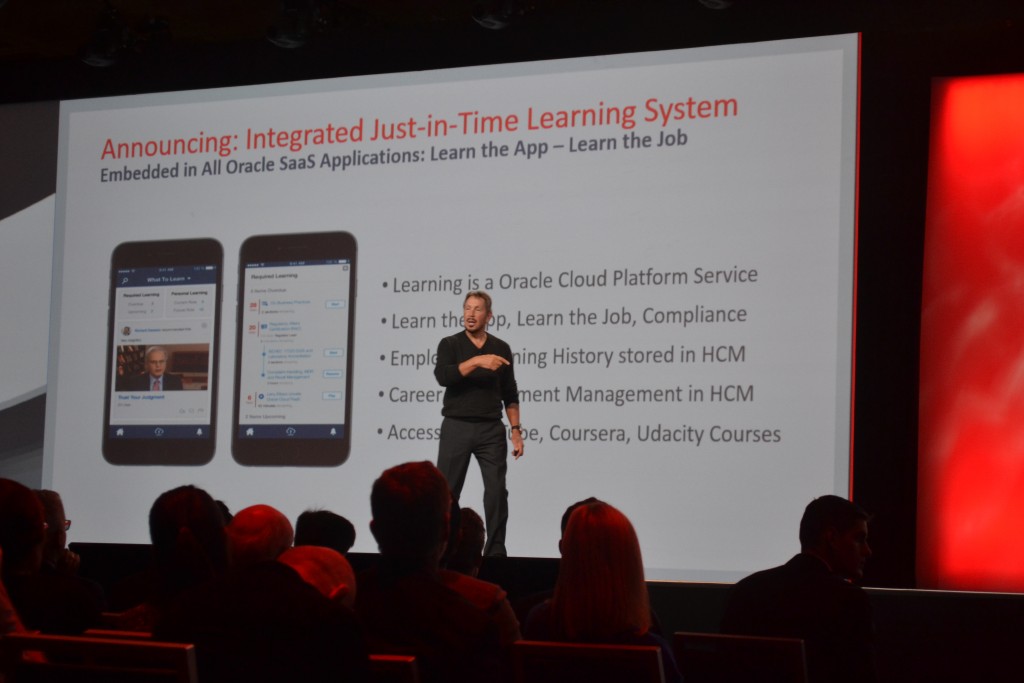
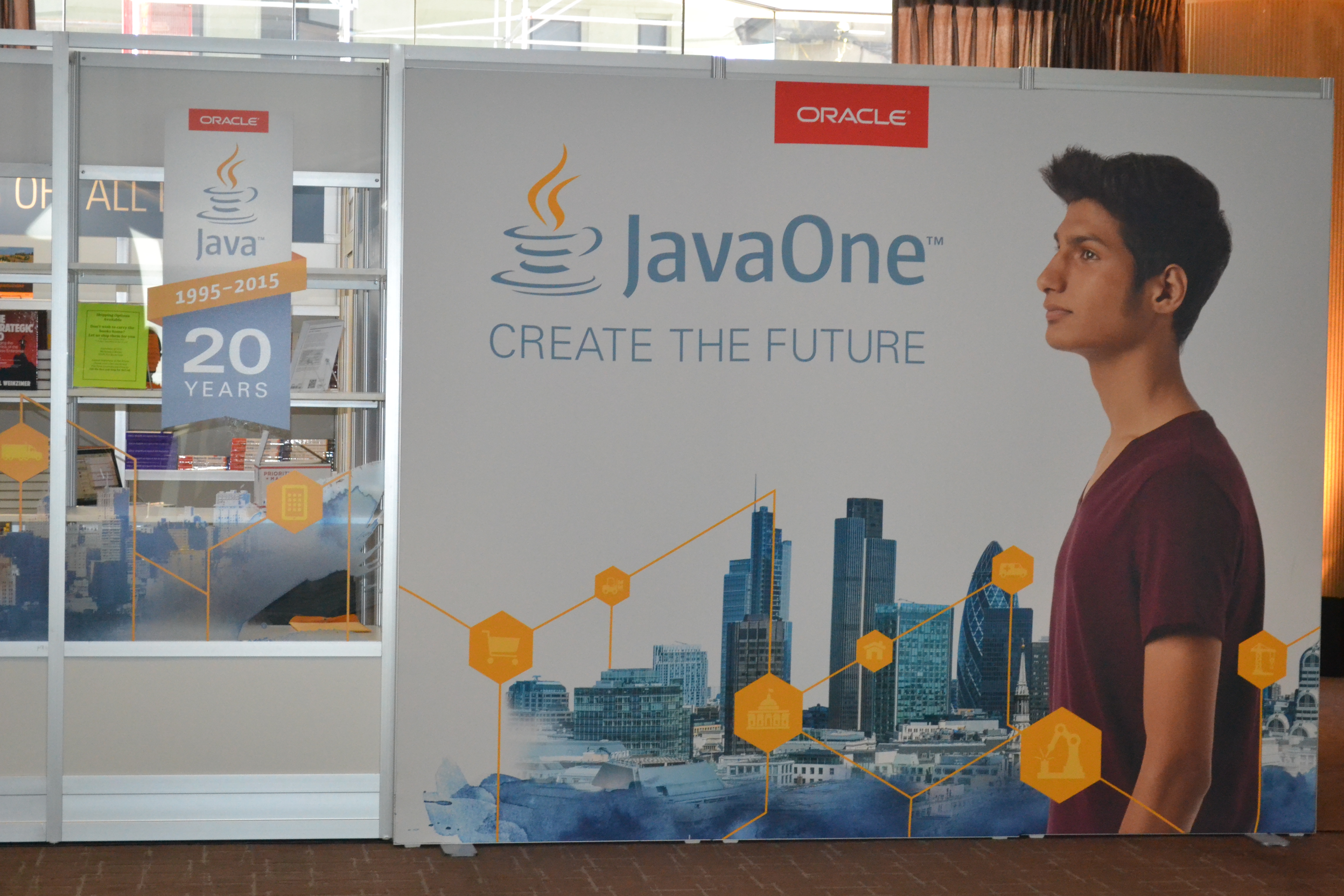
by Lidia Paulinska | Nov 17, 2015
Java celebrated its 20 years anniversary with the giant cake on the stage of Moscone North at Oracle – Java Open World conference this year in San Francisco and the speakers highlighted the most memorable Java events of the last two decades. Scott McNealy, longtime CEO and co-founder of Sun Microcomputers that was acquired by Oracle, joined the Java keynote via internet. As an iconic executive & passionate programmer Scott shared his top 12 Java developer nightmares of 2015 making the audience laugh.
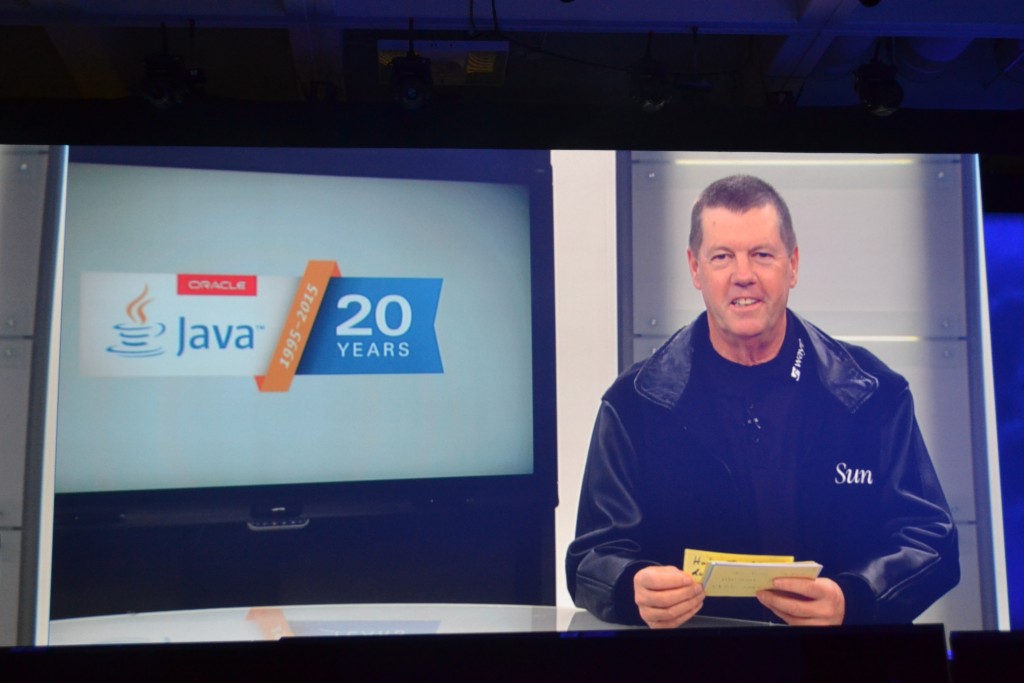
Former Sun CEO Scott McNealy
As of today, Java devices outnumber the number of people on the earth. There are 13 billion devices running Java, including 200 million medical and 1 billion automotive devices. It is the number one development platform with 10 million developers worldwide. The platform is strong and continues to move forward not only on devices, but in the cloud as well. The key for these products, is not just smart sensor but the network and connectivity of any device to the cloud, so it communicates to the cloud and back. On the top of that connectivity, the Java environment has a real time system of analytics that transforms the network to knowledge network.
 The growth of Java is closely connected and driven by the growing IoT market. So the question to be asked is how big is IoT? There were many estimates given at the conference on how the IoT market is going to grow for next few years. They vary from 50 billion to 200 billion devices. Ericson and Cisco estimate 50 billion, Morgan Stanley 75 billion, but IDC expected 200 billion.
The growth of Java is closely connected and driven by the growing IoT market. So the question to be asked is how big is IoT? There were many estimates given at the conference on how the IoT market is going to grow for next few years. They vary from 50 billion to 200 billion devices. Ericson and Cisco estimate 50 billion, Morgan Stanley 75 billion, but IDC expected 200 billion.
Java simplifies the development of the products. Today kids are coding with Java. Next generation of Java developers are creating animations, modifying Minecraft, building Lego Mindstorms, programing NAO robots and Raspberry Pi devices, and more.
Congratulations Java and wish you many more years.

Java 20yr Cake and developers

by Lidia Paulinska | Nov 8, 2015
In 1983, a long time before Hollywood audiences fell in love with Computer Generating Imagery, also commonly known as “CGI”, the first experiment in a commercial motion picture film that combined live action and archival footage took place. This happened in Woody Allen’s groundbreaking film, “Zelig”, which he wrote, directed and starred in. Allen was the first filmmaker to use CGI in his production, which would be the beginnings of CGI, which would transform films into places we’ve never been before. CGI would forever assist the filmmaker in making his historical storytelling credible to all audiences.
“Zelig”, which is no doubt one of his most brilliant storytelling gems from Allen’s catalog of films is about a freak documentary about Leonard Zelig, who has paranormal abilities, like a chameleon who changes himself just by looking at someone; for example, in a presence full of Chinese people, he would change right before your eyes and become Chinese. The culmination scene is when Leonard one day disappears all of the sudden under unclear circumstances, and the psychologist, played by Mia Farrow, who is in love with him, and has been desperately searching for him until she saw him in the movie theatre movie screen, that was screening news from the world. At that moment, Leonard is standing amongst the crowd of people saluting the Adolf Hitler in Nazis Germany. Here is a beginning of a new computer technique that allowed Leonard to be pasted in the archive footage of that time.
The next major motion picture production using CGI was “Forrest Gump, directed by Robert Zemeckis, a story about a not very intelligent man that by accident became involved in historical events. The film won six Academy Awards, and many scenes would be never forgotten, as well as memorable quotes: “Life is like a box of chocolates…you never know what you’re gonna get.”. Forrest Gump was full of historical figures like JFK, Nixon or Elvis Presley. After the critical and commercial artistic success of “Forrest Gump”, CGI became the King of Hollywood.
“Zelig” was a black and white movie because the computer technology did not advanced to the point to solve matching colors. Ten years after “Zelig” was made, Forrest Gump made that possible.
However, computer technology is not that simple that can be seen from outside. It takes time and effort to build it. The producers of the last American hit, “Avengers”, were sharing their challenges, especially with the battle scene on the street of the city. The main characters were created in the computer and then carefully applied to match against the panoramic view of New York where the film was shot. Matching the colors became the ultimate challenge to the point that was easier to build the city on the computer. The production took one year.
Nothing easier is with animation movies that seem to be under full control of graphic computer designers. Building the reality using the CGI has the limitations as movement, gestures and mimic of the human face. But there are no doubts that technology is more and more advanced.
However, manipulation with computer images would not replace what is cinema about – the story.
The new HBO production “Hemingway and Gellhorn”, which was first aired on HBO on May 2012, utilized the archive footage from the domestic war in Spain, the Japanese invasion in China, and finally the Hemingways’ home in Cuba. Directed by Philip Kaufman, film is a saga about Hemingway and his third wife, Martha Gellhorn, starring Cliff Owen and Nicole Kidman.
According to the movie it was Hemingway, who made Gellhorn a full pledge war correspondent (describe what you see your own eyes, Gellhorn) and had a big influence on her writing. In exchange she was credited for inspiring him to write a novel “For Whom the Bell Tolls”. Serving as a reporter in Spain in 1936 was just beginning of her carrier which she became dedicated to the rest of her life. She went to Spain, China, Finland, Hong Kong, Burma, Singapore and Britain. She became more obsessed with it that Hemingway who, while she was away, stayed in their house nearby Havana, Cuba and was sending angry letters to her “Are you a war correspondent or my wife?”.
Now nearly everything that Hollywood produces is mainly CGI, most of them sacrificing the stories. However, CGI, can truly enhance films. They are essential tools that need brilliant filmmakers who have a real historical story to tell, like Woody Allen, Robert Zemeckis, or Philip Kaufman.

by Lidia Paulinska | Nov 8, 2015
In the last five years, the word “smart” was used to describe a device that combines few functions; the primary function connected to the internet. For example, a smartphone or smart TV. However, smart means much more than that. This word is associated with the ability to analyze and make decisions. That’s why in the not too distant future these devices will be equipped with some intelligence and calling them smart will be precise and accurate.
The foundation is there. Two significant events took place during the last three years. In 2011, the computer machine called “Watson”, invented by IBM, won the American television show “Jeopardy”. For the first time, the machine defeated the human in a contest of mind exercises. IBM tends to challenge the existing technology about once a decade. In 2006, a few engineers noticed that Ken Jennings was accumulating long victories on “Jeopardy”. They thought it would be interesting to make a computer system that could challenge the best human expert in the show. The challenges for the computer were: working with human languages, applying probabilities to the responses, selecting the best answer, all within the 3 seconds allowed for a buzz-in and before the human contestants.
After 5 years of development, Watson was ready to pick up the fight and win!
The second event took place in 2012, when a driverless Google car completed over 300.000 driving miles (500.000 kilometers) accident free. As a result, three U.S. states: California, Nevada and Florida have passed laws permitting driverless cars on their roads. In March 2012, Google posted a YouTube video showing a Morgan Hill, California, resident, Steve Mahan being taken aboard on the self-driving Toyota Prius. In the video, Mahan who is 95% blind was taken from his home to the dry cleaners and then back home.
Creating artificial intelligence is possible by using many sensors that are built into a device. Those sensors collect the data and based on the information the computer system makes the decisions. The more sensors that are built into the device, the more factors are analyzed; therefore more precise and accurate decisions are made.
In addition, the sensors that are built into the cars collect and provide the information not only about consumption of gas or malfunction but also defines the drive style based on analyzing many factors. So if the owner of the car will allow the insurance company to have access to this information, he or she can claim a better insurance package.
In the near future, this data will become the new currency.

by Lidia Paulinska | Nov 7, 2015
As part of a valuable cultural service, Fathom Events presented Oscar Wilde’s classic comedy of manners,The Importance of Being Earnest at selected theaters in the U.S. for a one-night-only screening November 3, 2015. The performance was a filmed live production on October 8th, 2015 at London’s Vaudeville Theatre in commemoration of the play’s 120th anniversary.
As an iconic “comedy of manners” and one of the funniest plays in the English language, “Earnest” exaggerates the absurd superficiality of upper-class Victorian society, emphasizing the “importance of being earnest,” with “earnestness” having the connotation of intense conviction, dependability, and unflappable honesty. Being earnest was an integral part of the moral code of honor nominally practiced by upper-class Victorians. However, in practice, Wilde reminds us, “In matters of grave importance, style, not sincerity is the vital thing.”
The primary comic conceit in Wilde’s play deals with his clever use of the word earnest used both as an adjective in the afore mentioned sense, and Ernest as a noun…capitalized, minus the “a”, and being a proper man’s name. The confusion and interchangeability of the names between the two main characters, Algernon and Jack, the latter professing to be “…Ernest in town and Jack in the country,” forms the core of the play’s driving force of satire and duplicity, and an irony based on the characters’ violation of the very essence of being earnest through their abiding dishonesty. Jack is certainly not earnest when he pretends to be Earnest in the city but “Jack” in the country and the wit continues unabated throughout this Victorian romp.
Deftly directed by Adrian Noble (Amadeus, The King’s Speech) with a pitch-perfect cast featuring the incomparable David Suchet (Agatha Christie’s Poirot), as the irrepressible, irascible Lady Bracknell, The Importance of Being Earnests is rollicking high farce and wit at it’s very finest. Algernon is in love with Cecily, Jack is smitten by Gwendolyn, and both are forced to adopt the names “Ernest” because the objects of their affections cannot tolerate a man with any name other than “Ernest.”
Ironically of course, they forego the moral code of honesty associated with earnestness in order to satisfy their romantic interests. However, all is resolved in the end and the two couples are joined to live happily ever after.
In the final scene of the play, Lady Bracknell comments to Jack, “My nephew, you seem to display signs of triviality,” to which Jack replies as he and Gwendolyn happily exit stage left arm-in-arm, “On the contrary, Aunt Augusta, I’ve now realized for the first time in my life the vital Importance of Being Earnest.”
Curtain.
Review by Lidia Paulinska and Hugh McMahon




















